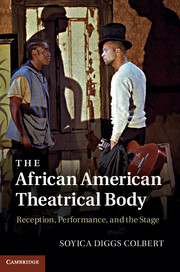Book contents
- Frontmatter
- Contents
- Illustrations
- Acknowledgements
- Overture: rites of reparation
- Chapter 1 Repetition/reproduction: the DNA of black expressive culture
- Chapter 2 Recuperating black diasporic history
- Chapter 3 Reenacting the Harlem Renaissance
- Chapter 4 Resisting shame and offering praise and worship
- Chapter 5 Resisting death: the blues bravado of a ghost
- Chapter 6 Rituals of repair
- Chapter 7 Reconstitution
- Epilogue Black movements
- Notes
- Bibliography
- Index
Chapter 2 - Recuperating black diasporic history
W.E.B. Du Bois' The Star of Ethiopia
Published online by Cambridge University Press: 05 November 2011
- Frontmatter
- Contents
- Illustrations
- Acknowledgements
- Overture: rites of reparation
- Chapter 1 Repetition/reproduction: the DNA of black expressive culture
- Chapter 2 Recuperating black diasporic history
- Chapter 3 Reenacting the Harlem Renaissance
- Chapter 4 Resisting shame and offering praise and worship
- Chapter 5 Resisting death: the blues bravado of a ghost
- Chapter 6 Rituals of repair
- Chapter 7 Reconstitution
- Epilogue Black movements
- Notes
- Bibliography
- Index
Summary
At the same time ‘human’/‘humanity’ is not read in the light of ‘African-American.’
As an unexplored narrative resource, black personality elaborates human freedom as a single chapter of transition between the beginning and the end.
Hortense SpillersThunder sounds, lightning strikes, wild beasts roar, tom toms beat, and one hundred men and women fill the stage in the opening scene of William Edward Burghardt Du Bois' (1868–1963) The Star of Ethiopia. The storm that opens Du Bois' pageant, composed of five scenes in twelve episodes, quickly subsides once the Kushites who fill the stage offer a blood sacrifice to Shango, the thunder god. The pageant purposefully intertwines the grandeur of the opening scene – which, in addition, Du Bois scripted to include a lion that crosses the foreground of the stage and a two-hundred-member choir – with mysticism as a method to begin the historical lesson the pageant sought to distill. The force behind the history then, from the beginning of the pageant, is a specific African force that has particular implications for black people in the western world. Originally staged in New York as The People of Peoples and Their Gifts to Men (1913), The Star of Ethiopia played to thousands in Washington, DC (1915), Philadelphia (1916), and Los Angeles (1925) (Figure 4). As Du Bois explains in “The Drama among Black Folk,” twelve hundred African American participants staged the pageant at the American League Ball Park in Washington, DC to a racially mixed, although predominantly African American audience. According to the Washington Bee, the cast presented ten thousand years of history in five scenes narrated through music and dance.
Unparalleled in historical scope, The Star of Ethiopia revised the American pageant, a form that flourished in the United States from 1905 to 1925. Du Bois' pageant presents an international landscape instead of recounting a local history, altering the geographical scope of American pageants at the time. As a result, the play expands the democratic potential of the pageant form and the meaning of American community to include bodies from diverse spaces and geographical locations. Besides stretching the geographical boundaries of the American pageant form, in 1915 Du Bois extended the pageant from a dramatic work that sought to teach a historical lesson to an epistemology of history. Owing to the grand scale of the productions and size of the casts of pageants in general and Du Bois' pageant in particular, its formal qualities made it an ideal medium to further Du Bois' philosophical project – presenting the black world as composed of modern subjects and historical actors. Du Bois imbued the quotidian definition of actor – one who performs an action – with purpose by having ordinary citizens play the part of revolutionary historical actors. In addition, his project entailed demonstrating the relationship between the creation of the black subject and the modern subject. By bridging the cleavage between modern subjectivity and revolutionary subjectivity, Du Bois hoped to quicken African Americans' investment in exercising their democratic privilege to be free acting agents of history. Du Bois first presented the relationship between modern subjectivity and revolutionary subjectivity in his description of double consciousness.
- Type
- Chapter
- Information
- The African American Theatrical BodyReception, Performance, and the Stage, pp. 48 - 90Publisher: Cambridge University PressPrint publication year: 2011



